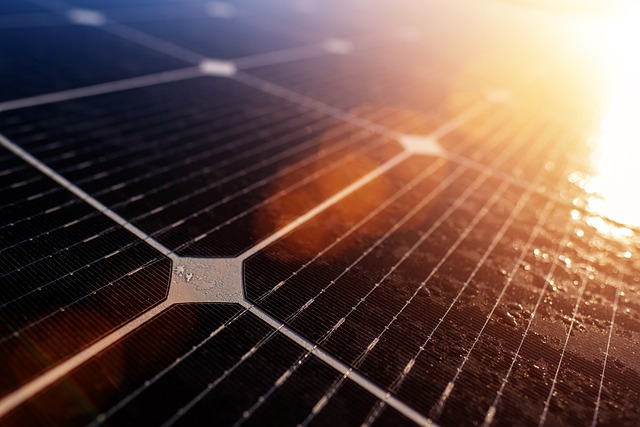In Desert Center, California, a startling transformation is taking place. Amidst the arid plains and sun-soaked mountains of the Mojave desert, a vast expanse of sparkling blue stretches across the Chuckwalla Valley.
From a distance, it appears as a pristine lake, but upon closer inspection, the truth is revealed – it is an expansive sea of solar panels, a low-res computer-rendered mirage that has overtaken the landscape.
Over the past years, this once-empty desert has witnessed the relentless spread of one of the world’s largest clusters of solar power plants.
The Riverside East Solar Energy Zone, at the heart of California’s solar energy boom, now sprawls across 150,000 acres, dwarfing Manhattan tenfold.
As the United States aims to achieve 45% of its electricity from solar power by 2050, these massive solar farms are seen as a crucial component of the country’s green energy revolution.
However, the federal Bureau of Land Management, responsible for facilitating these projects on public land, appears to have overlooked a critical aspect – the desert is not as uninhabited as it seems.
Beyond its barren appearance, this stretch of the Mojave is a fragile habitat for endangered species, home to ancient Indigenous cultural sites, and hundreds of people’s residences.
Residents have reluctantly witnessed the encroachment of solar plants, bringing with them noise, pollution, and a steady erosion of their way of life in this desert sanctuary.
The Lake Tamarisk resort, a community for those over 55 near Desert Center, finds itself increasingly surrounded by solar farms. Mark Carrington, a resident, expresses the community’s frustration, stating, “We feel like we’ve been sacrificed. We moved here for the clean air, but some days I have to go outside wearing goggles. What was an oasis has become a little island in a dead solar sea.“
Recent news of the Easley project, which would position solar panels just 200 meters from their backyards, has heightened concerns among residents.
They argue that excessive water consumption by solar plants has contributed to the depletion of local wells, while property values have plummeted, making it difficult to sell their homes.
Teresa Pierce, a resident, shares the psychological toll of living in this transformed landscape, from constant construction noise to relentless dust storms. She now experiences allergies she never had before, feeling like a prisoner in her own home.
Environmental experts raise alarms about the cumulative impact of these projects on the desert’s populations, both human and non-human. Kevin Emmerich, a former National Park Service employee and founder of Basin & Range Watch, highlights the numerous problems associated with solar plants, such as habitat destruction and the creation of “lethal death traps” for birds mistaking the panels for water. One project alone bulldozed 600 acres of critical habitat for the endangered desert tortoise, and other species like the Mojave fringe-toed lizards and bighorn sheep have also been affected.
The desert renewable energy conservation plan (DRECP), approved in 2016 to prevent such adverse impacts, has faced criticism for its flawed process that disregards conservationists’ concerns. Despite its intention to preserve wildlife routes and critical habitat, the individual assessments for each solar project fail to consider the cumulative impact, obstructing endangered species’ natural transport corridors across the desert.
Beneath the desert’s seemingly barren surface lies a hidden universe. Dry wash woodlands, composed of shrubs and trees with extensive underground root systems, play a vital role in carbon sequestration.
These desert plants capture carbon dioxide at the surface and store it underground as layers of sedimentary rock called caliche, preserving the carbon for thousands of years.
Unfortunately, by uprooting and bulldozing vast areas of desert land for solar farms, we are unknowingly disrupting this delicate carbon sequestration process.
The removal of these native plants and the disturbance of the desert soil could potentially release stored carbon back into the atmosphere, exacerbating the issue of climate change that solar energy aims to combat.
Additionally, the construction and maintenance of solar farms require substantial amounts of water, a precious resource in desert environments. Critics argue that the excessive water consumption by these projects contributes to the depletion of already strained local water sources, further exacerbating water scarcity issues for both humans and wildlife.
Despite the environmental consequences, the demand for renewable energy in California shows no signs of slowing down. The state has set ambitious goals to achieve 100% clean energy by 2045, driving the rapid expansion of solar farms. However, finding a balance between renewable energy development and environmental preservation is a challenge that requires careful consideration, accurate scientific data, and planning to ensure we all get the best possible results.
To address these concerns, stakeholders must prioritize a comprehensive approach that considers the cumulative impact of solar projects on the desert ecosystem. It is essential to involve local communities, Indigenous groups, conservationists, and scientific experts in the decision-making process to ensure the preservation of vital habitats, cultural sites, and the well-being of residents.
Moreover, exploring alternative approaches to solar energy generation should be part of the conversation. Advances in technology offer possibilities like floating solar arrays on man-made reservoirs or integrating solar panels into urban environments, reducing the need for massive land use in ecologically sensitive areas.
As California and the rest of the world strive to transition to clean energy, it is crucial to learn from the lessons unfolding in the Mojave Desert. By implementing sustainable practices, conducting thorough environmental assessments, and engaging in inclusive dialogue, we can strike a balance between renewable energy development and the protection of our precious ecosystems. Only through careful consideration and proactive measures can we ensure a future where solar energy and environmental preservation go hand in hand.




